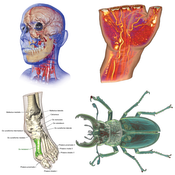Information
- Publication Type: PhD-Thesis
- Workgroup(s)/Project(s):
- Date: March 2008
- Date (Start): July 2004
- Date (End): March 2008
- TU Wien Library:
- Rigorosum: 11. April 2008
- First Supervisor: Eduard Gröller
- Keywords: volume rendering, illustrative visualization
Abstract
Illustrations are essential for the effective communication of complex subjects. Their production, however, is a difficult and expensive task. In recent years, three-dimensional imaging has become a vital tool not only in medical diagnosis and treatment planning, but also in many technical disciplines (e.g., material inspection), biology, and archeology. Modalities such as X-Ray Computed Tomography (CT) and Magnetic Resonance Imaging (MRI) produce high-resolution volumetric scans on a daily basis. It seems counter-intuitive that even though such a wealth of data is available, the production of an illustration should still require a mainly manual and time-consuming process.This thesis is devoted to the computer-assisted generation of illustrations directly from volumetric data using advanced visualization techniques. The concept of a direct volume illustration system is introduced for this purpose. Instead of requiring an additional modeling step, this system allows the designer of an illustration to work directly on the measured data. Abstraction, a key component of traditional illustrations, is used in order to reduce visual clutter, emphasize important structures, and reveal hidden detail. Low-level abstraction techniques are concerned with the appearance of objects and allow flexible artistic shading of structures in volumetric data sets. High-level abstraction techniques control which objects are visible. For this purpose, novel methods for the generation of ghosted and exploded views are introduced.
The visualization techniques presented in this thesis employ the features of current graphics hardware to achieve interactive performance. The resulting system allows the generation of expressive illustrations directly from volumetric data with applications in medical training, patient education, and scientific communication.
Additional Files and Images
Additional images and videos
 Teaser:
Illustrative visualization results
Teaser:
Illustrative visualization results
Additional files
 print version:
High-resolution version for printing
print version:
High-resolution version for printing
 screen version:
Low-resolution version for screen viewing
screen version:
Low-resolution version for screen viewing
Weblinks
No further information available.BibTeX
@phdthesis{bruckner-2008-IIV,
title = "Interactive Illustrative Volume Visualization",
author = "Stefan Bruckner",
year = "2008",
abstract = "Illustrations are essential for the effective communication
of complex subjects. Their production, however, is a
difficult and expensive task. In recent years,
three-dimensional imaging has become a vital tool not only
in medical diagnosis and treatment planning, but also in
many technical disciplines (e.g., material inspection),
biology, and archeology. Modalities such as X-Ray Computed
Tomography (CT) and Magnetic Resonance Imaging (MRI) produce
high-resolution volumetric scans on a daily basis. It seems
counter-intuitive that even though such a wealth of data is
available, the production of an illustration should still
require a mainly manual and time-consuming process. This
thesis is devoted to the computer-assisted generation of
illustrations directly from volumetric data using advanced
visualization techniques. The concept of a direct volume
illustration system is introduced for this purpose. Instead
of requiring an additional modeling step, this system allows
the designer of an illustration to work directly on the
measured data. Abstraction, a key component of traditional
illustrations, is used in order to reduce visual clutter,
emphasize important structures, and reveal hidden detail.
Low-level abstraction techniques are concerned with the
appearance of objects and allow flexible artistic shading of
structures in volumetric data sets. High-level abstraction
techniques control which objects are visible. For this
purpose, novel methods for the generation of ghosted and
exploded views are introduced. The visualization techniques
presented in this thesis employ the features of current
graphics hardware to achieve interactive performance. The
resulting system allows the generation of expressive
illustrations directly from volumetric data with
applications in medical training, patient education, and
scientific communication.",
month = mar,
address = "Favoritenstrasse 9-11/E193-02, A-1040 Vienna, Austria",
school = "Institute of Computer Graphics and Algorithms, Vienna
University of Technology ",
keywords = "volume rendering, illustrative visualization",
URL = "https://www.cg.tuwien.ac.at/research/publications/2008/bruckner-2008-IIV/",
}


 screen version
screen version